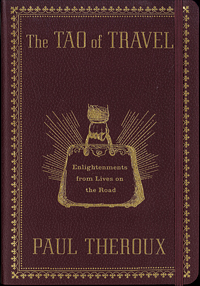Paul Theroux is one of the world’s premier travel writers, the author of such titles as ‘The Great Railway Bazaar: By Train Through Asia’ (1975), ‘The Old Patagonian Express’ (1979) by train through North and South America; ‘Riding the Iron Rooster’ (1988) on trains in China; ‘Ghost Train to the Eastern Star’ (2008) retracing some of the 1975 trip; and many more. Theroux likes trains (and a lot more). But, did he ever ride the Janakpur or Darjeeling lines?
Theroux also has 28 fiction titles, most recently: ‘A Dead Hand: A Crime in Calcutta’ (2009). His 1981 novel, ‘The Mosquito Coast’, is one of my favorites. It was made into a film shot in Belize (Central America) in which the final conflagration (a horrendous explosion and fire) was staged with the pyrotechnic help of a contingent of Nepalese Gurkha soldiers stationed in that former British colony.
 Theroux has also written the critically acclaimed ‘V.S. Naipaul: An Introduction to His Work’ (1972).
Theroux has also written the critically acclaimed ‘V.S. Naipaul: An Introduction to His Work’ (1972).
Theroux’s ‘The Tao of Travel’ (2011) is a remarkable accomplishment, a gem of a book, one that every serious traveler and travel writer will want to own. That’s no overstatement. It’s a ‘must have’ compendium of travel wisdom, a treasure trove of insight and ageless observations.
In the Preface, ‘The Importance of Elsewhere’, Theroux writes: “All my traveling life I have been asked the maddening and oversimplifying question ‘What is your favorite travel book?’... Then, the travel narrative, he tells us, is “the oldest in the world, the story the wanderer tells to the folk gathered around the fire after his or her return from a journey. ‘This is what I saw’ – news from the wider world; the odd, the strange, the shocking, tales of beasts or of other people...” Never ending; seldom boring.
Early in the book we are introduced to Dervla Murphy’s practical Rules of Travel. For example: “Choose your country..., identify the areas most frequented by foreigners — and then go in the opposite direction.” “Mug up on history.” “Invest in the best available maps.” “Be cautious — but not timid.”
Murphy is the brave Irish lady who bicycled from Ireland to India and Nepal in the early 1960s to work with Tibetan refugees at Pokhara. After that she made a career of cycling and writing the world. Her earliest books are ‘Full Tilt: Ireland to India with a Bicycle’ (1965), ‘Tibetan Foothold’ (1966), and ‘The Waiting Land: A spell in Nepal’ (1967).
In ‘The Tao’, Theroux introduces us to thoughts on travel by such great litterateurs as Henry Fielding, Samuel Johnson, Robert Louis Stevenson, and Evelyn Waugh. Dickens is also there, and Isabella Bird, James Boswell, Sir Richard Burton and Lord Byron, Emerson and Hemingway, Pico Iyer and Flaubert, and others. Among the earliest are Sir John Mandeville, Marco Polo, and Ibn Battuta.
The vast majority of what Theroux quotes is from Western writers, with a sprinkling of others including South America’s Gabriel Garcia Marquez, India’s Vikram Seth, the Japanese Zen practitioner Bashō whose long walk across Japan resulted in a classic of 17th century Asian travel writing, and the 7th century Chinese Buddhist scholar and “ultimate pilgrim” Xuanzang (Hsüan-tsang) who journeyed to South and Southwest Asia and described the great Buddha statues of Bamiyan in Afghanistan (destroyed by the Taliban in 2001).
The most direct reference to Nepal in ‘The Tao’ is excerpted from ‘The Snow Leopard’, Peter Matthiessen’s 1978 account of a scientific expedition and spiritual pilgrimage to The Crystal Mountain in Dolpa.
Theroux concludes with Five Travel Epiphanies based on personal experience. The first reveals a travel truism. Back in 1963, while boarding a plane in Italy, the young Theroux had no money to pay the mandatory departure tax. The stranger behind him in line saw his predicament and handed him twenty dollars. When Theroux said he’d like to repay the man sometime, the stranger replied: “I’ll probably see you again. The world’s a small place.”










